Luxurious inflorescences on autumn flowerbeds attract the eye and amaze with a variety of shades. Indoor chrysanthemum in a pot differs from congeners in open ground in the compact shape of a spherical bush 20–40 cm high. Breeders bred several hybrids and varieties adapted to lack of lighting and other indoor conditions.
Material Content:
Indoor plants are not small copies of garden forms
"Home" chrysanthemums are not demanding to care for, grow well, bloom profusely and easily propagate. In everyday life, it is customary to say "flowers", although the family of Asteraceae has a basket inflorescence. When buying, you should pay attention to ensure that there is a healthy chrysanthemum in a pot, home care will be much easier then. A well-developed plant, intended for indoor use, will continue flowering on the windowsill. Under favorable conditions, the buds can open almost without interruption for 2 years.
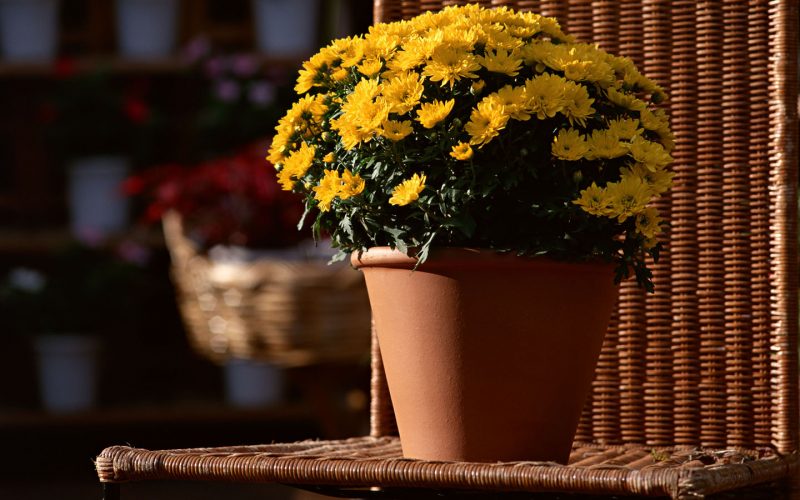
It should be noted that after self-propagation by cuttings or root offspring, new plants do not turn out to be as compact and dense as purchased in a store.
Street chrysanthemums are sold in plastic containers. Such flowers are planted in open ground, or left in containers, used for container gardening, decorating a patio, and entering a house.After flowering, the stems are cut, containers with roots are sent for the winter to the basement or loggia. If street chrysanthemum is kept indoors, the leaves will turn yellow and dry. These plants need fresh air and a certain lighting mode - the night is longer than the day.
Potted Chrysanthemum Varieties
Thanks to the efforts of breeders, geneticists and agrochemists, plants have been bred that can bloom profusely and for a long time in the room. In total, about 40 hybrid varieties of chrysanthemums were created for indoor cultivation. Inflorescences can be smaller or the same size as in open-ground plants. Often varieties are grouped by origin from one natural species.
Chrysanthemum indian
In nature, this is a relatively low herbaceous plant. Toothed leaves, green-gray. An inflorescence is a basket resembling a daisy with yellow petals and the same core. It is the ancestor of small-flowered hybrids for growing on the windowsill and balcony.
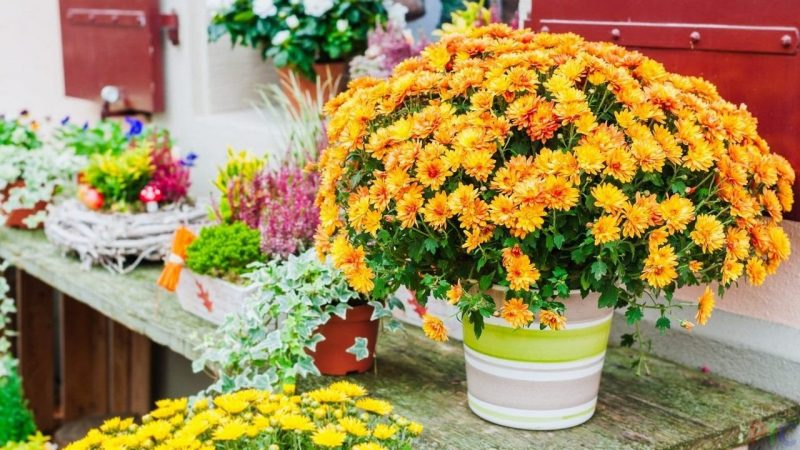
Indian chrysanthemum was crossed with species having white and pink color inflorescences. Breeders with the help of chemicals that affect growth, received compact forms with a height of 20-25 cm. Today there are a large number of different forms and varieties that feel good in the room, are in high demand. The flower is liked and appreciated for its rich color and long flowering, which is especially attractive in the cold period of time.
Popular varieties of chrysanthemums in indoor floriculture:
- "Golden Gloria" - dense bushes with a large number of large yellow inflorescences.
- "Old Gold" - plants with petals of an unusual reddish-bronze color.
- "Morifolium" is a variety with large simple, semi-double and double inflorescences 5 cm in diameter.
Chinese Chrysanthemum

A group of varieties and hybrids for the creation of which several species were used. Indoor floriculture plants have a compact shape, thin, highly branched stems 20–25 cm high. Saturated green leaves, 7 cm long and 4–5 cm wide. Point glands are visible on the upper side of the leaf blade. Inflorescences of Chinese chrysanthemums are simple, semi-double and double, of various sizes and colors.
Home Care for Chrysanthemums
Buy a plant in a flower shop or accept as a gift. In any case, it is necessary to create conditions in the new room so that the buds do not fall. Planting and caring for chrysanthemum in a room is different from open ground and a greenhouse.
Lighting, temperature
Light affects the flowering and opening of buds. The amount of light that is provided when placing the pot on the windowsill of plastic or wooden windows facing west and east is suitable. If the rays hit at noon, it can cause leaf burns; in this situation, it is recommended to shade the plant. A young bush blooms with a daylight duration of 6-8 hours in October or November (depending on the region).
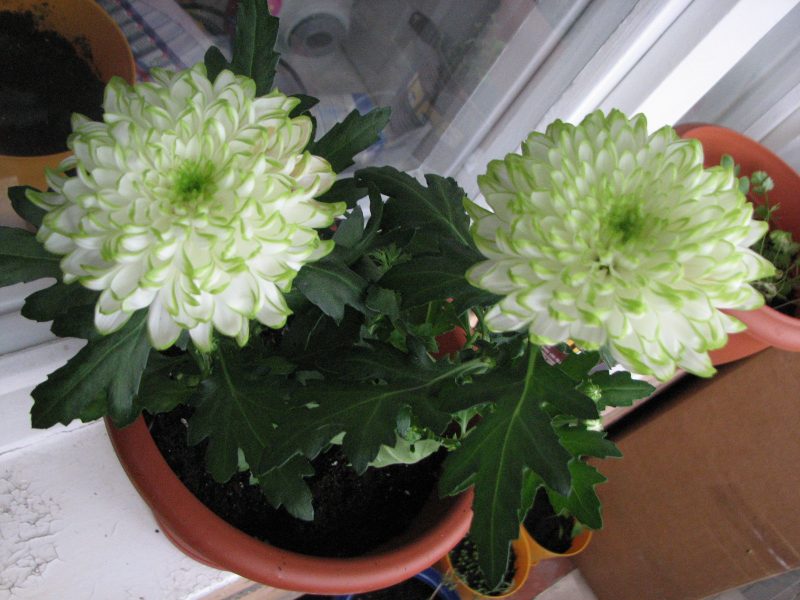
The temperature comfortable for room chrysanthemum is 18–23 ° С. The variety, more demanding of the conditions of detention, responds to the heat by dropping buds and leaves. It is advisable to spray the plant with water more often in the summer to lower the temperature. You can leave it in front of an open window, the chrysanthemum is not afraid of drafts.
More materials:potted chrysanthemum
Watering and feeding
The soil in the pot should always be moist. Indoor chrysanthemum prefers frequent irrigation, but not excessive. Stagnant water in the pot can lead to rotting of the roots, the spread of fungal and bacterial diseases.
Read also:multiflora chrysanthemum
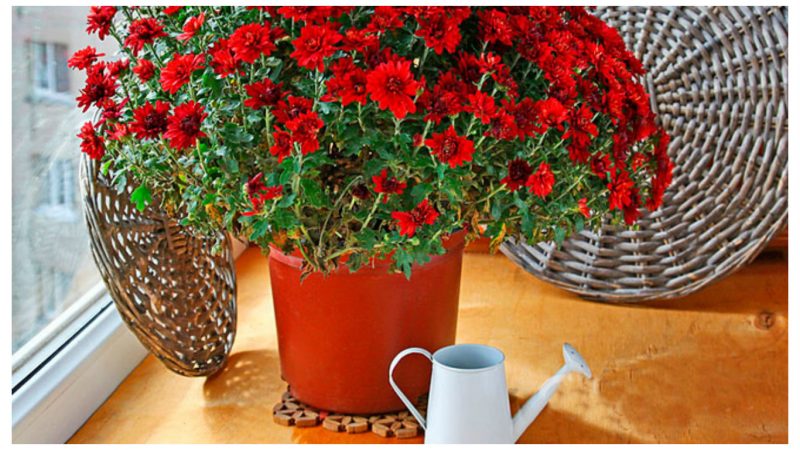
Recommendations to flower growers:
- The substrate must not be allowed to dry out.
- In autumn and winter, watered once a week in the morning.
- Watering in spring and summer is carried out 2 times a week in the evening.
- In the heat, water is sprayed near indoor plants to lower air temperature.
- Use for irrigation and spraying settled water. If it is hard, then a white coating accumulates on the surface of the soil.
- Avoid droplets on the flowers.
Abundantly blooming chrysanthemums require more frequent fertilization. Conduct liquid dressing once a week until the end of flowering. It is advisable to use complex fertilizers with the addition of trace elements. Actively growing shoots need nitrogen, during budding and flowering more potassium and phosphorus are required. The plant is fed in a pot about 12 hours after watering.
Trimming and shaping a bush
The purchased plant for a long time retains its original form. If you do not further regulate the growth of shoots, then several long stems appear, which reduces the decorativeness.

Recommendations:
- Perform pinching of rapidly growing shoots. Small-flowered chrysanthemums will need 2 or 3 treatments.
- Large-flowered hybrids can be formed in the form of a tree, for which shorten the main shoot and cut the lower branches.
- Pinching beginners to wither inflorescences helps to increase the number of new buds.
Pruning is necessary in case of delayed flowering. Selective pinching of the tops of the peduncles will provide a flow of nutrients to the remaining buds.
Plant transplant
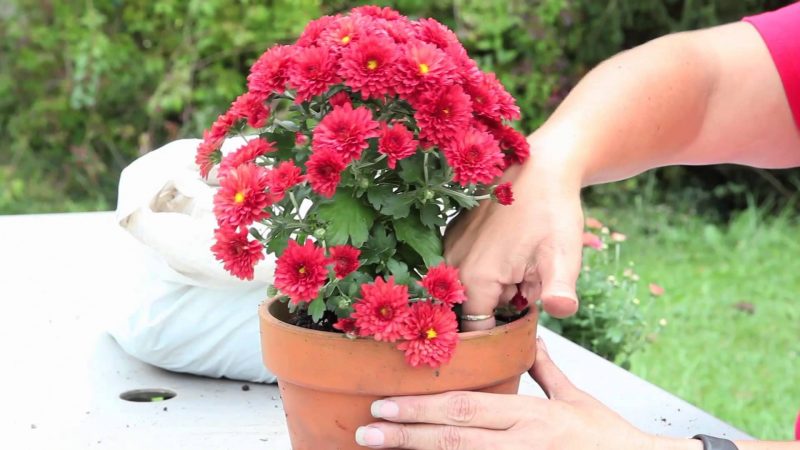
Young and old plants need updating the substrate. Transferred to a deeper and wider pot once a year - in the spring or early summer. The substrate is prepared from garden soil, peat and humus (1: 1: 1). You can use ready-made soil for indoor flowers.
For chrysanthemums, such indicators as loose structure, lightness, water capacity and soil nutrition (mechanical composition and fertility) are important.
After transplantation, young offspring are covered with a plastic glass, adult plants with a plastic bag. At first they provide diffused lighting, do not forget about watering.
Features after flowering
After flowering is completed, weak and diseased shoots are removed. Some gardeners recommend trimming the stems, leaving short patches above the surface of the substrate. After that, the soil is watered and the pot is cleaned in a cool, dry place until spring.
You can do without radical pruning, leave the chrysanthemum in its original form on the windowsill in the room. The third option: to stimulate the growth of shoots and the formation of a compact bush, pruning is done, but the pot is not removed. A strong chrysanthemum in the same season will start new shoots and bloom.
Propagation of chrysanthemums at home
Adult chrysanthemums "acquire" root offspring (children). From these additional shoots, young plants can be grown. Root offspring are carefully separated from the mother bush, planted in small containers. It is necessary to maintain the depth of the plant at the same level. To do this, increase the height of the drainage layer or place the roots higher. Cover the seedlings with a plastic glass. In the autumn of that year, young plants will bloom.
Rooting of stem cuttings:
- Cut young shoots from an adult plant.
- Fill a transparent plastic container from cookies or cakes with well-washed sand.
- Cuttings are planted, covered with a lid from the container.
- After the formation of roots and the appearance of new leaves, young plants are transplanted into a pot.
Chrysanthemums are difficult to grow from seeds. Hybrid varieties are often sterile. Usually, during seed propagation of chrysanthemums, varietal characters are not preserved.
It is interesting:Hoya care
The main problems when growing plants
Why do leaves turn yellow?

Chrysanthemum leaves change color due to improper care and disease. Yellowing may be due to a lack of light, water, hot air from a heating battery. The appearance of spots of a grayish-yellow or brown color with a yellow border is a sign of a fungal infection. If yellowing is associated with poor care, it is easier to correct this deficiency than to treat plant diseases.
Chrysanthemum does not bloom - why?
Typical reasons for the lack of buds and flowers are lack or excess of lighting. Chrysanthemum is a short-day plant. If the room has artificial lighting in the morning and in the evening, then biorhythms get lost. Another reason is associated with the rapid growth of stems and leaves, which happens with an excess of fertilizing and the absence of pruning.
Diseases and pests of indoor chrysanthemum
The plant is susceptible to rust, powdery mildew, gray and black rot. These fungal infections are treated with fungicides for indoor plants. Aphids, black midges of sciaridae, soil mites, and nailstail are harmful to chrysanthemum. The leaves are treated with a solution of Actellik, Fitoverm or Bazudin. For spraying, flowers are taken out to the balcony. Window sills, window frames are washed with a solution of soda and soap.
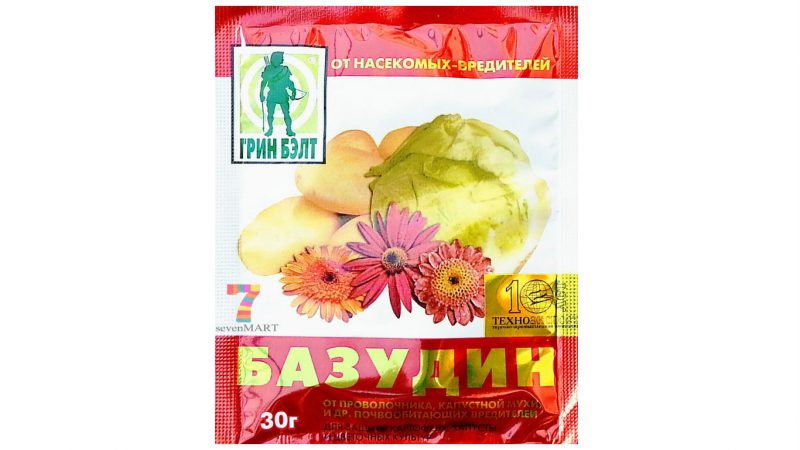
After the death of the pests, the topsoil in the pot is changed to a depth of 2 cm. It is recommended that you carefully consider the choice of substrate. Typically, pathogens and plant pests are found in land brought from the garden.
It is very important to isolate the affected plant from the rest of the green pets in the room, to timely control pests and diseases. Then chrysanthemums will remain healthy, will delight in blooming for a long time.












